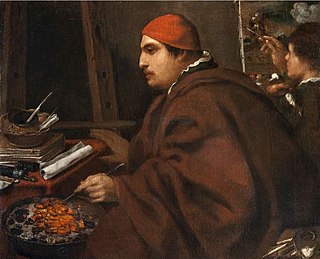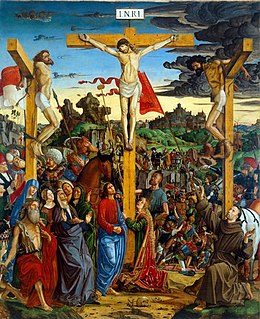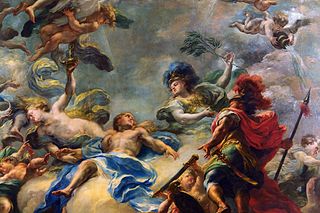
Francesco Naselli was an Italian painter of the Baroque period.

Francesco Naselli was an Italian painter of the Baroque period.
He was born at Ferrara, and flourished about the year 1610. When young, he studied the works of the Carracci and Guercino, which he copied with surprising success, but afterwards devoted himself to the manner of his countryman Giuseppe Mazzola. He was employed for several of the churches in Ferrara. In the Cathedral there is an altarpiece by him, representing the Nativity ; in the church of Santa Maria de' Servi, a large picture of the Last Supper ; and in the church of Santa Francesca, the Assumption of the Virgin.
Naselli died at Ferrara about 1630. He is said to be the father of Alessandro Naselli, another Ferrarese painter. [1] [2]

Francesco Vanni was an Italian painter, draughtsman, printmaker, publisher and printer active in Rome and his native city of Siena.
The School of Ferrara was a group of painters which flourished in the Duchy of Ferrara during the Renaissance. Ferrara was ruled by the Este family, well known for its patronage of the arts. Patronage was extended with the ascent of Ercole d'Este I in 1470, and the family continued in power till Alfonso II, Ercole's great-grandson, died without an heir in 1597. The duchy was then occupied in succession by Papal and Austrian forces. The school evolved styles of painting that appeared to blend influences from Mantua, Venice, Lombardy, Bologna, and Florence.

Ortolano was an Italian painter of the Ferrara School, active in the Renaissance period. Ticozzi cites his birth as ca. 1480.

Francesco Costanzo Catanio, was a painter of the Italian Baroque period, born and mainly active in Ferrara. He was variously known as Catanio, Cattani, Cattaneo, or Cattanio, sometimes without the forename Francesco.

Giuseppe Caletti or Calletti was an Italian painter and engraver of the Baroque period, active in Ferrara and Cremona. He often painted religious themes in a genre like dress and surroundings, including the theme of Bacchanalia like Titian.
Giuseppe Antonio Ghedini was an Italian painter of the Baroque period, mainly active in Ferrara.
Alfonso Rivarola was an Italian painter of the Baroque period, active mainly in Ferrara, where he was born. He is also known as il Chenda because of an inheritance he received from someone with that name.

Giovanni Francesco Surchi was an Italian painter of the late-Renaissance period, active in Ferrara.

Antonio Randa was an Italian painter of the classicist period, active in Ferrara, Modena, Rovigo, Florence, Comacchio and his native Bologna.
Antonio Bonfanti was an Italian painter. He was also called Il Torricella. He was a native of Ferrara, where he painted a Presentation of Mary at Temple and Dispute among Doctors for the chancel of the church of San Francesco and a Holy Family for the church of La Santissima Trinità. He was a pupil or follower of Guercino. His brother Giulio was also a painter.

Gabriele Cappellini was an Italian painter of the Renaissance. He was also called il Caligarino or il Calzolaretto, from his having first pursued that trade. He was born in Ferrara, and there trained under Dosso Dossi, he was active c. 1520. For the church of San Francesco, Ferrara he painted a St. Peter and St. James and for San Giovannino the principal altar-piece, representing The Virgin and Infant with several Saints.

Francesco Bianchi was an Italian painter of the Renaissance period. He is also known as Francesco del Bianchi Ferrara and Il Frare. He was born at Ferrara. Modena is also mentioned as the place of his birth. His works were much esteemed in his time. He was a pupil of Cosimo Tura. He is said to have been an instructor of Correggio, but Bianchi would have died when the former was only 16 years old.

Giacomo del Pò, also spelled del Po, was an Italian painter of the Baroque. He was born in Palermo, the son of Pietro del Pò who was also his teacher.

Pablo da San Leocadio or Paolo da Reggio was an Italian painter from Reggio Emilia, who was mostly active in Spain.

Camillo Filippi was an Italian painter who flourished about the middle of the 16th century.

Domenico Mona (1550–1602) was an Italian painter of the late-Renaissance period, born in Ferrara.

The Church of the Theatines (Teatini), also known as Santa Maria della Pietà is a Roman Catholic, Baroque-style church and monastery located on Corso della Giovecca, in central Ferrara, region of Emilia-Romagna, Italy.
Alessandro Naselli was an Italian painter, active in his native Ferrara in the mid to late 17th century. He was active in a late Mannerist style during the Baroque period. In addition to his tutelage of his father, the Ferrarese painter, Francesco Naselli, he was a pupil of Costanzo Cattani Some of his works can be seen in the Church of Theatines, Ferrara.

Ferrara Charterhouse, of which the present Church of San Cristoforo alla Certosa was previously the monastic church, is a former charterhouse or Carthusian monastery built in Renaissance style, located on Piazza Borso 50 in Ferrara, Region of Emilia-Romagna, Italy. The monastery was suppressed in the time of Napoleon, but the church was reconsecrated in 1813 and remains in use. The site also accommodates a large municipal cemetery, which was established in 1813.

Lamentation was a 1587-1590 oil on canvas painting by Annibale Carracci, destroyed with other Carracci works such as Danaë at Bridgewater House in May 1941 during the London Blitz. Prints and copies of it survive, the best being those by the Ferrara painter Francesco Naselli now in Mantua's city library.
Attribution: